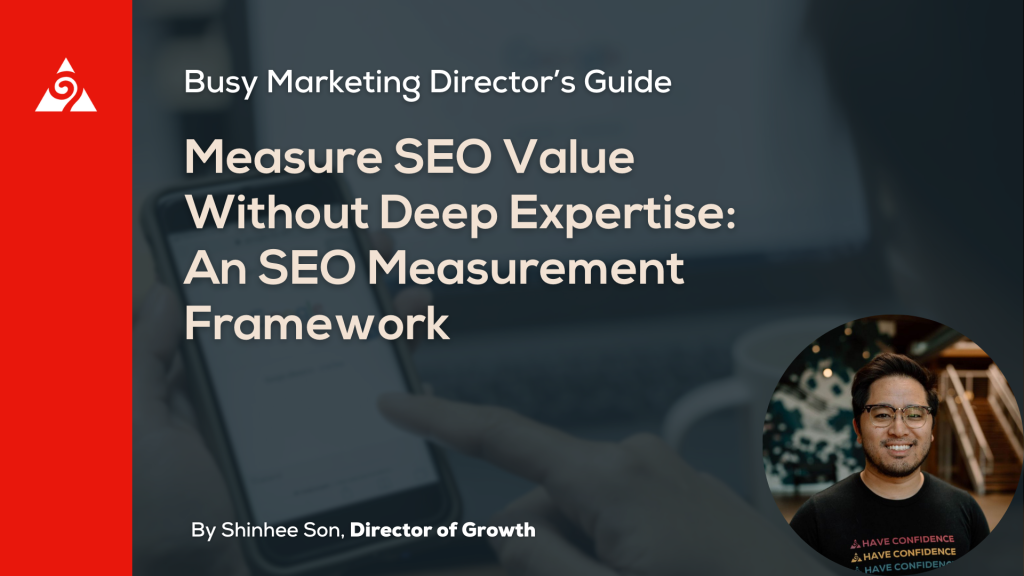As a marketing director, you’re probably feeling the pressure from leadership to show results from SEO, even with a tighter budget and less experience in analytics. It can be tricky to figure out how to measure SEO performance without getting into the weeds of the technical stuff.
The good news is that you don’t have to be an SEO expert to show results. By setting clear goals that match your company’s business objectives and tracking the right metrics, you can create a simple plan to show quick wins and long-term growth. In this guide, we’ll walk you through how to measure SEO’s impact so you can show leadership the results they want to see, even with fewer resources.
1. Align SEO with Business Goals
Start with leadership to define how SEO can help the company meet its business goals. Ask questions like:
- Is the focus on increasing leads or sales through organic traffic?
- Do we want to improve brand visibility in search engines?
- Are we looking to reduce our reliance on paid ads and lower customer acquisition costs (CAC)?
Once you understand their priorities, set specific SEO goals aligning with them. For example, if the goal is lead generation, focus on driving more organic traffic to high-conversion pages. If the goal is reducing CAC, track how SEO reduces the need for paid ads. By aligning your SEO goals with business needs, you’ll know exactly what to report on and can show how SEO supports overall success. As you can see, your SEO strategy drastically changes based on the business goals.
Additionally, it is crucial to measure SEO success through KPIs that align with these business goals, ensuring that your SEO efforts lead to a tangible return on investment.
2. Focus on Key SEO Metrics
SEO Metrics Leadership Will Care About
- Revenue: Track how much revenue SEO efforts drive to show the financial impact.
- Conversions: Measure actions like lead form submissions or sales from organic traffic.
- SEO Traffic: Track how many visitors come from organic search to demonstrate growth.
- Search Market Share: Show how your website ranks against competitors.
These metrics help measure SEO performance by quantifying traffic and engagement, providing actionable insights for improving SEO strategies.
SEO-Specific Metrics for Tracking Progress:
- Keyword Rankings: Monitor your keyword ranking to ensure your target keywords are improving.
- Backlinks: Track the quantity and quality of backlinks to boost authority.
- Core Web Vitals/Page Speed: Ensure your site’s technical health for better rankings.
I’ve gone more in-depth about the 6 SEO metrics that matter.
3. Set Up Proper Tracking with Google Analytics
To get started, delegate this task to a team member or agency partner. Have them set up tools like Google Analytics and Google Search Console to track organic traffic, conversions, and keyword rankings. They should also use tools like Ahrefs or SEMrush to monitor backlinks and competitors. Make sure they review Core Web Vitals regularly for technical health. This allows you to focus on strategy while your team handles the details of tracking and reporting on SEO performance. Tracking search engine results is crucial to monitor visibility and impressions, ensuring your content effectively reaches potential users.
- Google Analytics (GA4): Set up goals and events to track organic traffic and its contribution to conversions.
- Google Search Console: Monitor keyword performance, site health, and indexing issues directly from Google’s data.
- SEO Tools (Ahrefs, SEMrush, or Moz): Use one of these tools to track keyword rankings, backlinks, and competitor analysis.
Don’t get too caught up with figuring out which SEO tool is the best here. They’re all directionally good enough. You can also just defer to your team to choose.
4. Prioritize Quick Wins
To get fast results, focus on these strategies and use simple criteria to guide your team:
- On-page SEO Optimization: Make sure titles, descriptions, and headers use target keywords. Prioritize high-traffic pages. Check that images are optimized for speed and have alt text.
- Content Audits: Focus on underperforming pages. Update outdated info or combine similar content. Prioritize pages that used to perform well but have dropped off.
- Internal Linking: Add keyword-rich links between relevant pages. Focus on high-traffic or important content.
- Technical Fixes: Use tools to find and fix broken links, missing alt text, or slow pages. Prioritize pages with the most traffic.
The pattern you’re looking for is simple: focus on opportunities that bring quick improvements with minimal effort. This means prioritizing easy-to-fix technical issues, optimizing pages with high traffic or conversion potential, updating outdated content, and improving internal linking between important pages. Additionally, focusing on strategies that quickly improve organic search traffic can significantly enhance your SEO effectiveness.
How to measure progress:
- Track keyword rankings before and after changes.
- Monitor traffic and conversion improvements for optimized pages.
- Check for faster load times and reduced bounce rates after technical fixes.
5. Highlight Long-term SEO Efforts
Explain to leadership that while some SEO improvements can show quick results, SEO is a long-term strategy that requires patience. Significant growth in organic traffic and top keyword rankings can take months, especially for competitive terms.
Set clear expectations that SEO builds over time and delivers sustainable, cost-effective traffic. Unlike paid ads, where results stop when the budget runs out, SEO continues to bring in traffic even after the initial work is done. Emphasize the long-term return on investment compared to other channels. Additionally, maintaining long-term visibility on search engine results pages (SERPs) is crucial for sustained click-through rates and overall online presence.
How to measure progress:
Track organic traffic growth, keyword rankings, and conversions over several months to demonstrate gradual improvements. Regular reporting on these metrics will help show how long-term efforts are paying off.
6. Report Regularly on SEO Performance
To keep leadership informed, set up a consistent reporting schedule highlighting short-term wins and long-term progress. Here’s a practical approach to start:
- Weekly Reports: Share brief updates on quick wins, such as keyword rankings, technical fixes, and on-page optimizations. Use tools like Google Analytics or Google Search Console to pull this data easily.
- Monthly Reports: Dive deeper into organic traffic trends, keyword movement, and conversions. Compare these to business goals to show how SEO is contributing. Highlight any noticeable changes in traffic, and use charts to make data easy to understand.
- Quarterly Reports: Conduct a strategic review of overall SEO health. Include backlink growth, content performance, and technical SEO improvements. Provide recommendations for further enhancements. Focus on long-term growth and how SEO improves cost-effectiveness compared to paid channels. Tracking specific metrics is crucial to measure SEO success, as it helps align SEO goals with broader business objectives and guides improvements.
Action Steps:
- Set up automatic reports in tools like Google Analytics or SEMrush to track key metrics.
- Create a simple reporting template for the team to fill in weekly.
- Use data visualization tools like Google Data Studio to create easy-to-read dashboards for leadership.
7. Visualize SEO Progress
To help leadership easily see the value of SEO, use Google Data Studio to create visual dashboards highlighting key metrics. Here’s how to make it actionable:
- Organic Traffic: Show growth trends with line charts.
- Keyword Rankings: Display keyword movements using simple graphs or tables.
- Conversions: Visualize the number of leads or sales from organic search.
- Site Health: Track metrics like Core Web Vitals and page speed. Include competitor comparisons on site performance for key rivals leadership cares about most.
8. Work with Experts or External Help
If SEO feels overwhelming, delegate complex tasks to experts. Here’s how:
- SEO Agency or Freelancer: Hire specialists for link-building, deep content strategy, or technical audits. This frees up your time and ensures SEO is handled by pros.
- Internal Team or Consultants: Collaborate with in-house SEO or web developers to manage technical fixes and content strategy. Make sure they execute your high-level plan effectively. Ensuring that your web content is accessible and correctly indexed by search engines is crucial for improving visibility on search engine results pages (SERPs).
9. Benchmark and Show Competitor Comparisons
Regularly compare your SEO performance with key competitors to give leadership valuable context. Use tools like Ahrefs or SEMrush to track:
- Organic Traffic Share: Show how your site’s organic traffic compares with competitors.
- Keyword Rankings: Display rankings for important industry keywords.
- Backlink Strategies: Highlight how your competitors’ backlink profiles stack up against yours.
This comparison helps position your SEO strategy within the market and shows opportunities for improvement. Analyzing search results provides competitive insights, illustrating how higher rankings can lead to increased website traffic and engagement.
10. Tie SEO to Revenue Impact
To demonstrate the financial impact of SEO, show leadership how it contributes to revenue. This can include:
- Organic Conversions: Highlight how organic leads, pipeline growth, or sales directly result from SEO efforts.
- Monetary Value of Organic Traffic: Estimate how much your organic traffic would cost if you had to pay for it (e.g., through paid search).
- SEO vs. Paid Channels: Show how SEO is a cost-efficient, long-term strategy compared to paid channels, which stop driving traffic once the budget is gone.
By framing SEO in terms of revenue and cost-efficiency, you can clearly demonstrate its value to leadership and manage expectations around both short-term results and long-term benefits. Additionally, tracking website traffic is crucial as it serves as a key metric to understand customer behavior and search performance.
Conclusion
Even without deep SEO expertise, you can start taking action by aligning SEO with your business goals, tracking key metrics, focusing on quick wins, and setting up regular reporting. Use data visualization to keep leadership engaged, and if needed, bring in experts for more complex tasks. You’ll show its value over time by tying SEO efforts to revenue.
If you want someone to handle this, consider requesting an audit. Click here or on the banner below to get started, and let us take SEO off your hands.
- Budgeting Content Marketing in 2024: How to Align Your Content Budget With Business Goals - September 9, 2024
- Budgeting Paid Media in 2024: How to Align Your Paid Media Budget With Business Goals - September 9, 2024
- Budgeting SEO in 2024: How to Align Your SEO Budget With Business Goals - September 9, 2024





